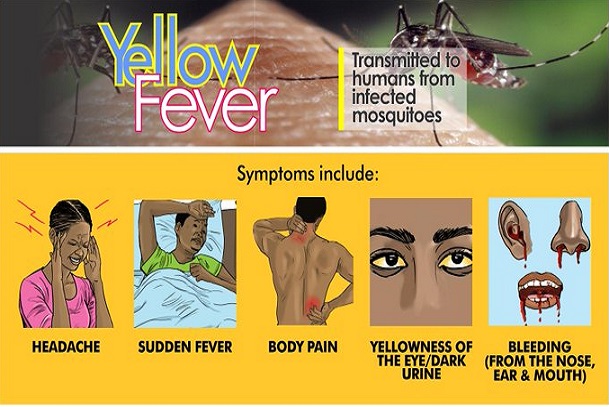 Wash your hands regularly and wear a face mask.
Learn more
Wash your hands regularly and wear a face mask.
Learn more

How Yellow Fever Presents
Most people who are infected with the yellow fever virus do not always develop symptoms or do have mild symptoms. But for those who develop initial symptoms of yellow fever, there may be indistinguishable from those of malaria, dengue fever, or other viral hemorrhagic fevers.
The symptoms usually have an incubation period between 3 – 6 days i.e., it will take about 3 days at least before yellow fever symptoms present themselves after a person may have been infected. Yellow fever spreads from one individual to another through infection-carrying mosquitoes (the Aedes and Haemogogus species) which spread the disease to humans.
The main symptoms of yellow fever are usually high temperature, a slow pulse, albuminuria, jaundice, congestion of the face, and hemorrhage or bleeding. But in mild cases, it causes fever, headache, nausea, and vomiting.
When yellow fever becomes more serious, it tends to cause heart, liver, and kidney problems with bleeding (hemorrhaging), with up to 50% of patients with severe forms of yellow fever dying of the disease.
Yellow fever does have three stages of symptoms – the incubation stage, the acute stage, and the toxic stage (a life-threatening stage)
Incubation Stage
This is the first stage of yellow fever disease that occurs between a 3 – 6 days incubation period. At this stage, most individuals do not have any form of symptoms or show any signs of contracting the disease.
Acute Stage
This is the second stage of yellow fever, and during this period an individual may experience the following:
These symptoms usually disappear within 7 – 10 days, and they normally improve after a few days, but 15% of people do enter the third stage (toxic stage, having more severe and life-threatening symptoms.
Toxic Stage
With signs and symptoms disappearing after a day or two following the acute stage, some individuals with acute yellow fever do enter the toxic stage. At this stage, the signs and symptoms return and become more severe and life-threatening. The symptoms include:
Between 20% - 50% of people who develop toxic stage symptoms die within two weeks. And within 7 – 10 days, yellow fever is fatal in around half of the people who enter the toxic stage, and those who recover do not generally have any organ damage and have lifetime immunity.
Diagnosing Yellow Fever
Diagnosing yellow fever based on signs and symptoms can be difficult because early in its course, the infection can be easily confused with malaria, typhoid, viral hepatitis, dengue fever (and other viral hemorrhagic fevers), and poisoning.
Diagnosis of yellow fever is based on the clinical history of exposure to a mosquito bite in an endemic region, as well as a history of symptoms. Blood sample(s) will be analyzed for the presence of the virus or for the antibodies meant to fight the virus.
Polymerase chain reaction (PCR) testing in blood and urine can sometimes detect the virus in the early stages of the disease. In later stages, testing to identify antibodies is needed (ELISA and PRNT).
There are a few tests that can support or confirm the diagnosis of yellow fever. They include:
Difference Between Yellow Fever and Malaria
Most people tend not to be able to differentiate between yellow fever and malaria, especially after hearing that they are both caused by malaria. However, yellow fever is not the same disease as malaria, but they do have some things in common:
There are also significant differences between malaria and yellow fever, such as: